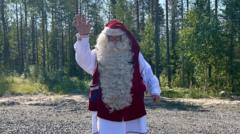As the summer sun beats down on Lapland, Santa Claus finds himself in an unusual position, advising his team of elves to stay hydrated amidst the sweltering heat. The famed Arctic region, usually associated with frost and snow, is reeling under a prolonged heatwave, with temperatures persisting around 30C for days. Santa, known for his iconic red attire adorned with fur, is wary of the heat and prefers to swim in the cool lake after sunset to beat the heat.
Lapland's capital, Rovaniemi, is adapting to this unusual weather phenomenon. The recent heatwave, ongoing for almost two weeks, is exceptionally rare for this northern territory, where high temperatures have been largely unheard of. Meteorologist Jaakko Savela of the Finnish Meteorological Institute points out that the previous record was set in 1972 when a heatwave spanned 12 to 14 days, making the current 15-day stretch notably significant.
This wave of heat is not limited to Rovaniemi; several weather stations across Lapland have recorded their longest and hottest heat events on record. Ylitornio and Sodankylä have registered a peak temperature of 31.7C, almost 10C above the seasonal average for the region.
As climate change accelerates, it places enormous pressure on the Arctic, which is warming at an alarming rate, reported to be four to five times faster than the rest of the globe. While this specific heatwave wasn’t solely caused by climate change, experts argue that climate change has inevitably raised overall temperatures which, in turn, has contributed to the intensity and frequency of such extreme heat events. Prof. Jeff Weller emphasizes the ongoing impact that climate change has on global weather patterns.
Even the famed reindeer, synonymous with Santa's sleigh, face challenges as they deal with heat and increasing mosquito populations that thrive in warmer conditions. As they venture into populated areas in search of relief, reindeer herders may need to consider constructing barns for shade to protect their animals during these scorching spells.
Tourists flocking to Lapland to escape the summer heat are met with a bewildering experience. Visitors like Silvia from Prague are surprised by the unexpected temperatures, having packed clothing ill-suited for weather that feels more fitting for a beach than the Arctic. The long days, with light lasting up to 20 hours, keep temperatures elevated well into the late hours of the night.
In the midst of the rising temperatures, Santa's summer predicament highlights broader concerns about the impact of climate change on the Arctic. As his elf, Elina, muses about the future of Lapland's winters, Santa himself longs for the return of cooler days, stating, “Of course a hot summer can be very nice for some but I prefer cold and snow. Winter is better.” The narrative of Santa navigating his way through a summer heatwave serves as a stark reminder of the changing climate and the urgency for awareness and action to protect cherished environments.
Lapland's capital, Rovaniemi, is adapting to this unusual weather phenomenon. The recent heatwave, ongoing for almost two weeks, is exceptionally rare for this northern territory, where high temperatures have been largely unheard of. Meteorologist Jaakko Savela of the Finnish Meteorological Institute points out that the previous record was set in 1972 when a heatwave spanned 12 to 14 days, making the current 15-day stretch notably significant.
This wave of heat is not limited to Rovaniemi; several weather stations across Lapland have recorded their longest and hottest heat events on record. Ylitornio and Sodankylä have registered a peak temperature of 31.7C, almost 10C above the seasonal average for the region.
As climate change accelerates, it places enormous pressure on the Arctic, which is warming at an alarming rate, reported to be four to five times faster than the rest of the globe. While this specific heatwave wasn’t solely caused by climate change, experts argue that climate change has inevitably raised overall temperatures which, in turn, has contributed to the intensity and frequency of such extreme heat events. Prof. Jeff Weller emphasizes the ongoing impact that climate change has on global weather patterns.
Even the famed reindeer, synonymous with Santa's sleigh, face challenges as they deal with heat and increasing mosquito populations that thrive in warmer conditions. As they venture into populated areas in search of relief, reindeer herders may need to consider constructing barns for shade to protect their animals during these scorching spells.
Tourists flocking to Lapland to escape the summer heat are met with a bewildering experience. Visitors like Silvia from Prague are surprised by the unexpected temperatures, having packed clothing ill-suited for weather that feels more fitting for a beach than the Arctic. The long days, with light lasting up to 20 hours, keep temperatures elevated well into the late hours of the night.
In the midst of the rising temperatures, Santa's summer predicament highlights broader concerns about the impact of climate change on the Arctic. As his elf, Elina, muses about the future of Lapland's winters, Santa himself longs for the return of cooler days, stating, “Of course a hot summer can be very nice for some but I prefer cold and snow. Winter is better.” The narrative of Santa navigating his way through a summer heatwave serves as a stark reminder of the changing climate and the urgency for awareness and action to protect cherished environments.




















